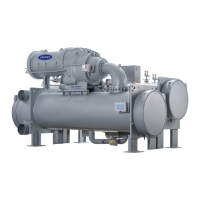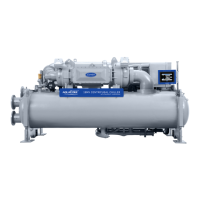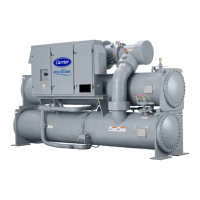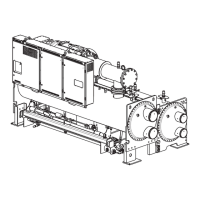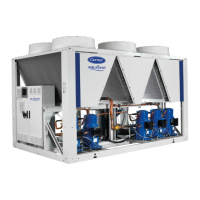98
screen). The TRANSDUCER VOLTAGE REF can be
measured across the positive (+ red) and negative
(– black) leads of the transducer. For example, the con-
denser transducer reference voltage is measured at CCM
terminals J2-4 (black) and J2-6 (red). The condenser
transducer input voltage is measured at CCM terminals
J2-4 (black) and J2-5 (clear or white). The input voltage
to reference voltage ratio must be between 0.80 and 0.11
for the software to allow calibration. Pressurize the
transducer until the ratio is within range, then attempt
calibration again.
4. A high pressure point can also be calibrated between 25
and 250 psig (172.4 and 1723.7 kPa) by attaching a regu-
lated 250 psig (1724 kPa) pressure (usually from a nitro-
gen cylinder). The high pressure point can be calibrated
by accessing the appropriate transducer parameter on the
HEAT_EX screen, highlighting the parameter, pressing
the softkey, and then using the
or softkeys to adjust the value to the exact
pressure on the refrigerant gage. Press the
softkey to finish the calibration. Pressures at high
altitude locations must be compensated for, so the chiller
temperature/pressure relationship is correct.
The PIC III controls do not allow calibration if the transduc-
er is too far out of calibration. In this case, a new transducer
must be installed and re-calibrated. If calibration problems are
encountered on the OIL PRESSURE DELTA P channel, some-
times swapping the oil pressure leaving filter and the oil sump
pressure transducer locations will offset an adverse transducer
tolerance stack up and allow the calibration to proceed.
TRANSDUCER REPLACEMENT — Since the pressure
transducers are mounted on Schrader-type fittings, there is no
need to remove refrigerant from the vessel when replacing the
transducers. Disconnect the transducer wiring by pulling up on
the locking tab while pulling up on the weather-tight connect-
ing plug from the end of the transducer. Do not pull on the
transducer wires. Unscrew the transducer from the Schrader
fitting. When installing a new transducer, do not use pipe sealer
(which can plug the sensor). Put the plug connector back on the
sensor and snap into place. Check for refrigerant leaks.
Control Algorithms Checkout Procedure —
One of the tables on the ICVC SERVICE menu is CONTROL
ALGORITHM STATUS. The maintenance screens may be
viewed from the CONTROL ALGORITHM STATUS table to
see how a particular control algorithm is operating.
These maintenance screens are very useful in helping to
determine how the control temperature is calculated and for
observing the reactions from load changes, control point over-
rides, hot gas bypass, surge prevention, etc. See Table 18.
Control Test — The Control Test feature can check all the
thermistor temperature sensors, pressure transducers, pumps
and their associated flow devices, the oil reclaim output, the
head pressure output, and other control outputs such as tower
fans, VFD cooling solenoid (if applicable), shut trip relay, oil
heaters, alarm relay, and hot gas bypass. The tests can help to
determine whether a switch is defective or if a pump relay is
not operating, as well as other useful troubleshooting issues.
During pumpdown operations, the pumps are energized to pre-
vent freeze-up and the vessel pressures and temperatures are
displayed. The Pumpdown/Lockout feature prevents compres-
sor start-up when there is no refrigerant in the chiller or if the
vessels are isolated. The Terminate Lockout feature ends the
Pumpdown/Lockout after the pumpdown procedure is reversed
and refrigerant is added.
LEGEND FOR TABLE 19
CAUTION
Be sure to use a back-up wrench on the Schrader fitting
whenever removing a transducer, since the Schrader fitting
may back out with the transducer, causing a large leak and
possible injury to personnel.
CCM — Chiller Control Module
CCN — Carrier Comfort Network
®
ICVC — International Chiller Visual Controller
CHL — Chilled Liquid
PIC III — Product Integrated Control III
VFD — Variable Frequency Drive
WSM — Water System Manager

